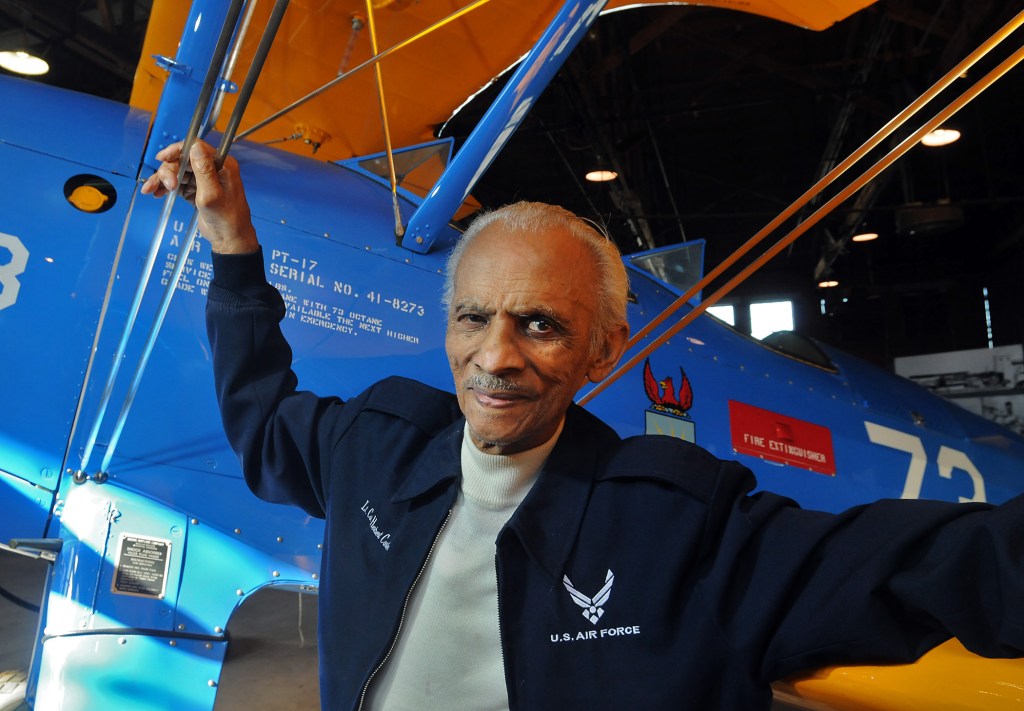Keesler trained mechanics for Red Tails
Published 8:53 am Friday, January 20, 2012

- Former Tuskegee Airman Herbert Carter, 94, of Tuskegee, poses with a PT-17 trainer aircraft in a hangar at Tuskegee Airmen National Historic Site at Moton Field in Tuskegee. "Red Tails," a film that chronicles the heroism of the Tuskegee Airmen, opens Friday, Jan. 20.
BILOXI, Miss. (AP) — When George Lucas shines the spotlight on the Tuskegee, Ala., Army Air Field with the Friday opening of “Red Tails,” what is now known as Keesler Air Force Base will not have a recognizable role.
The movie, after all, centers on the 332nd Fighter Group, the all-black fighter squadron based at Ramitelli, Italy, during World War II. They shattered the myth that black pilots could not fly or command as well as their white counterparts.
Movie-making constraints don’t allow sidebar stories for all of the 996 pilots and an aviation-support staff of thousands more.
The Army Air Corps’ Keesler Field in Biloxi graduated its first class of black airplane mechanics in August 1944. Upon completion of training, these men rejoined their unit at Tuskegee, Ala., where the first Army Air Corps pilots were trained.
If “Red Tails” could, however, tell the whole Tuskegee story, the Sun Herald reports (http://bit.ly/xrySe4 ) Keesler would play a small but proud part.
Keesler trained mechanics and others vital to keeping the Tuskegee pilots and their planes flying. Some pilots received training in Biloxi or were transitioned here before returning to Tuskegee, Ala., the only air base that graduated black pilots.
“Red Tails” is a historical drama based on real wartime events. The title comes from the nickname of the black pilots who, for distinction, painted the tails of their aircraft red.
After the war, some Tuskegee Airmen eventually returned to Keesler for further training or to teach when the Biloxi air base became an Air Force training center.
The Biloxi base was activated in 1941, six months before Pearl Harbor, as the Army Air Corps’ Keesler Field. Coincidentally, the War Department started construction of Tuskegee the same month.
By autumn 1943, more than 7,000 black airmen had trained at Keesler, including, like their white counterparts, pre-aviation cadets, radio and radar operators, technicians, mechanics and bombardiers.
Keesler histories and broader U.S. war overviews barely acknowledged the Tuskegee Airmen and the Keesler connection even less.
“When I joined the Air Force in 1955, Tuskegee was not a big part of Air Force history,” said Christopher C. Moore of Biloxi, a retired chief master sergeant and member of the local Lawrence E. Roberts Chapter of the Tuskegee Airmen.
The chapter is named for one of the best-known Tuskegee pilots associated with Keesler. Roberts, a 1944 Tuskegee graduate, died in 2004, a year after the chapter was formed.
Not many chapters today have “originals” from World War II, as fewer than 90 original Tuskegee Airmen are alive. The group’s goal is to keep the inspirational story alive through younger members.
Several books, occasional news coverage and two movies in the past decade have brought attention to these intrepid young black airmen. Their wartime exploits have yet to make Tuskegee a household name.
For 23 years, Lucas has tried to get the “Red Tails” story on the big screen. In recent interviews, the producer has talked about the reluctance of Hollywood to finance an all-black story with an all-back cast.
The Tuskegee Airmen’s overseas record includes thousands of sorties and bomber escorts and other missions that won them numerous Distinguished Flying Crosses and Unit Citations.
In 2007 — more than 60 years after the war — Tuskegee Airmen were awarded the Congressional Gold Medal.
For black airmen, the end of the war did not end the prejudice they and their families faced. Roberts’ widow, Lucimarian, recalls food and lodging denied to people of color, even those in the military. She recalls white airmen who picked up her husband for work did so covertly and black officers’ wives toed the local racial line or faced transfers to isolated duty stations such as Alaska.
“This was the way things were back then, not just at Keesler but in the whole South,” she said.
Lawrence Roberts and several other Tuskegee Airmen are buried at Biloxi National Cemetery, not far from the base where the New Jersey native began his military career as a pre-aviation cadet pilot.
Roberts then transferred to Tuskegee, earned his second lieutenant bars in 1944 and in a wide-ranging career returned to Keesler three more times before retiring in 1975.
“When we were here in 1949,” Lucimarian Roberts said, “Keesler was segregated because that was the times. When we came back in ’69, integration had started.”
When her husband retired, the family remained on the coast.
The Robertses never lost touch with other original Tuskegee Airmen.
“When Larry made full colonel there were only 25 black colonels, and he was one of the ‘youngsters,'” Lucimarian Roberts said.
“It was always a joy to attend a Tuskegee reunion. Each year there were fewer (attendees) but these aging men marched in, some stooped and bent over, some with oxygen tanks but all so proud of what they had accomplished.”
Among them is Grant S. Williams Sr., a retired chief master sergeant living in Hampton, Va.
“Americans tried their hardest not to let ‘colored people’ fly, because they didn’t think they had the ability to fly,” said Williams, 91, who was aviation support for Italy-bound fighters.
“What we all learned in our World War II experience and from Tuskegee was that we had to defend our own ability. We had to toe the line and do it better than anyone else was doing.”





